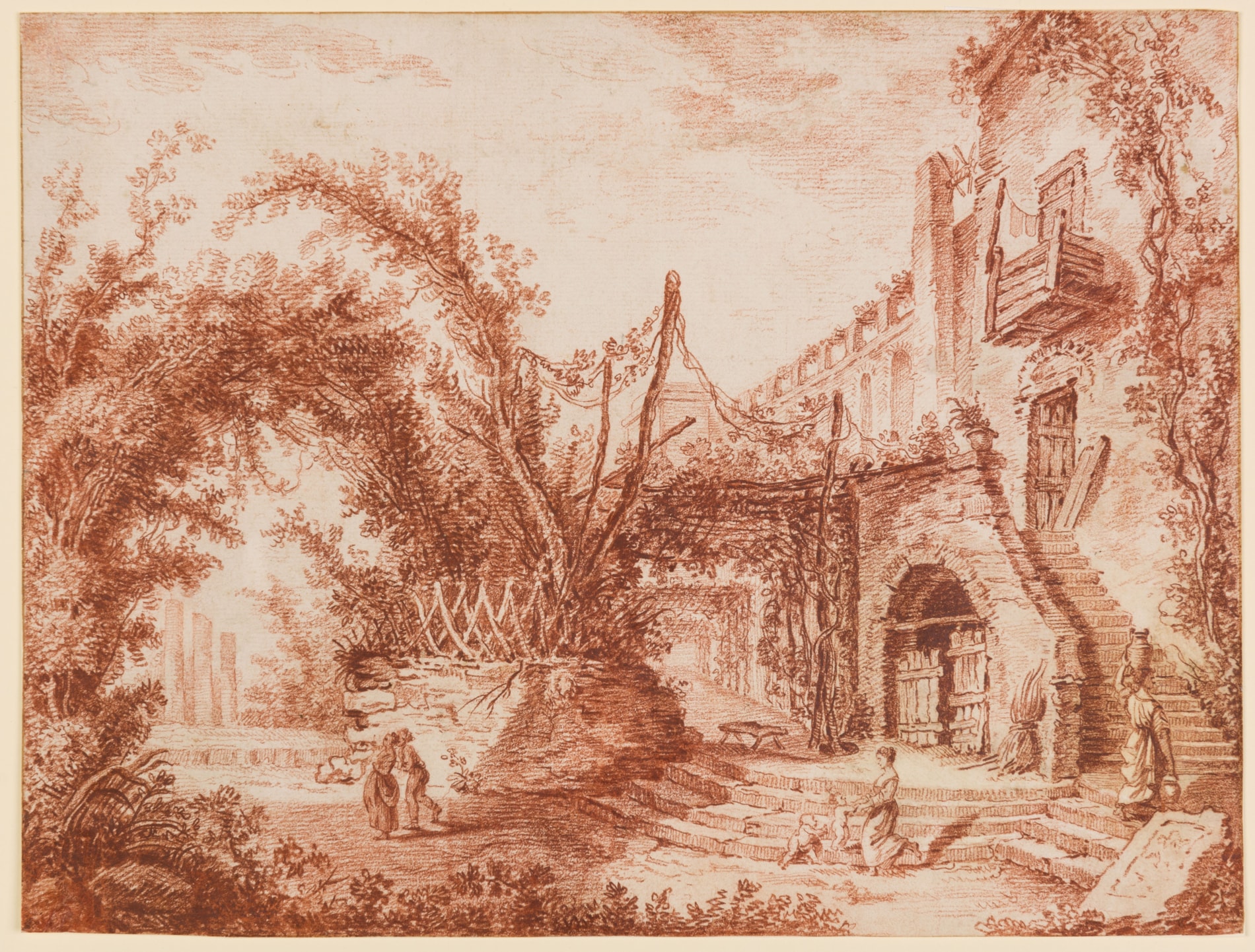Pierre-Adrien PÂRIS
(Besançon 1745 - Besançon 1819)
View of the ‘Temple of Jupiter Serapis’ at Pozzuoli, after Hubert Robert
Red chalk.
235 x 311 mm. (9 1/4 x 12 1/4 in.)
235 x 311 mm. (9 1/4 x 12 1/4 in.)
The present sheet is attributed to Pierre-Adrien Pâris, who made several first-rate drawn copies after the Italian landscape drawings of both Robert and Fragonard. The composition of the present sheet is derived from a slightly larger red chalk drawing of the so-called ‘Temple of Jupiter Serapis’ at Pozzuoli by Hubert Robert, today in a private collection. (A variant of the composition by Robert is in the collection of the Albertina in Vienna.) Robert’s drawing can be dated to 1760, when he and the Abbé de Saint-Non travelled together to Naples to prepare the illustrations for the Voyage pittoresque, ou description historique des royaumes de Naples, et de Sicile. The related engraving in the book is by Charles Guttemberg.
Although the present sheet follows Robert’s drawing fairly closely, there are a handful of significant differences between the two compositions, notably the figures of a man and a woman at the left of centre, which replace the two women found in Robert’s drawing and in other variants of the composition.
Excavated in 1750, the so-called Temple of Jupiter Serapis at Pozzuoli, on the outskirts of Naples, was long thought to have been a temple to the ancient god Serapis, due to the discovery of a statue of the Greco-Egyptian god at the site. It is now known, however, to have been the macellum, or public marketplace, of the town of Pozzuoli. The building was in the form of a square courtyard bordered by an arcade made up of thirty-four columns and decorated with statues. In the centre of the courtyard was a tholos; a circular building standing on a podium, with sixteen columns supporting a domed vault. By the 18th century, however, all that remained at the site was a row of three tall marble columns.
Although the present sheet follows Robert’s drawing fairly closely, there are a handful of significant differences between the two compositions, notably the figures of a man and a woman at the left of centre, which replace the two women found in Robert’s drawing and in other variants of the composition.
Excavated in 1750, the so-called Temple of Jupiter Serapis at Pozzuoli, on the outskirts of Naples, was long thought to have been a temple to the ancient god Serapis, due to the discovery of a statue of the Greco-Egyptian god at the site. It is now known, however, to have been the macellum, or public marketplace, of the town of Pozzuoli. The building was in the form of a square courtyard bordered by an arcade made up of thirty-four columns and decorated with statues. In the centre of the courtyard was a tholos; a circular building standing on a podium, with sixteen columns supporting a domed vault. By the 18th century, however, all that remained at the site was a row of three tall marble columns.
Raised in Switzerland, where his father worked as the architect to the Prince-Bishop of Basel, Pierre-Adrien Pâris enrolled in the Ecole Royale d’Architecture in Paris in 1860, studying under Etienne-Louis Boullée. Although he failed three times to win the Prix de Rome, he was able to study informally at the Académie de France in Rome, where he arrived in 1769. It was there that he met and came under the influence of Jean-Honoré Fragonard, whose drawings were to be a particular inspiration. He travelled extensively in Italy, making a particular study of the Roman ruins at Paestum, Pompeii and Herculaneum. On his return to France in 1774, he began working as an architect and decorator in Paris and elsewhere, and also met Hubert Robert at Versailles. In 1778 he was appointed dessinateur du cabinet du Roi to the King, Louis XVI. Two years later Pâris was admitted into the Académie Royale d’Architecture, and in 1784 was named architect of the Menus Plaisirs du Roi. Among his most significant projects were the decoration of the Opéra and the Elysée Palace in Paris, the construction of the town hall of Neuchâtel in Switzerland, and work on the Cathedral of Orléans. The Revolution found Pâris in semi-retirement, but by 1806 he was back in Italy, working in Rome and Naples and serving as acting director of the French Academy in Rome, while also helping to direct excavations at the Colosseum. He returned to France in 1817, and on his death two years later bequeathed his extensive collection – including sixty drawings by Fragonard - to the museum in his native city of Besançon.




